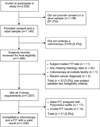Test characteristics of faecal immunochemical tests (FIT) compared with optical colonoscopy
- PMID: 24958730
- PMCID: PMC4143449
- DOI: 10.1177/0969141314541109
Test characteristics of faecal immunochemical tests (FIT) compared with optical colonoscopy
Abstract
Background: Faecal occult blood tests are often the initial test in population-based screening. We aimed to: 1) compare the results of single sample faecal immunochemical tests (FITs) with colonoscopy, and 2) calculate the sensitivity for proximal vs. distal adenomatous polyps or cancer.
Methods: Individuals scheduled for a colonoscopy were invited to complete a FIT prior to their colonoscopy preparation. FIT results were classified as positive, negative, or invalid. Colonoscopy reports were reviewed and abstracted. Because of product issues, four different FIT manufacturers were used. The test characteristics for each FIT manufacturer were calculated for advanced adenomatous polyps or cancer according to broad reason for colonoscopy (screening or surveillance/diagnostic).
Results: Of those invited, 1,026 individuals (43.9%) completed their colonoscopy and had a valid FIT result. The overall sensitivity of the FITs (95% confidence intervals) was 0.18 (0.10 to 0.28) and specificity was 0.90 (0.87 to 0.91) for advanced adenomas or cancer. The sensitivity for distal lesions was 0.23 (0.11 to 0.38) and for proximal lesions was 0.09 (0.02 to 0.25). The odds ratio of an individual with a distal advanced adenoma or cancer testing positive was 2.68 (1.20 to 5.99). The two individuals with colorectal cancer tested negative, as did one individual with high-grade dysplasia.
Conclusions: The sensitivity of a single-sample FIT for advanced adenomas or cancer was low. Individuals with distal adenomas had a higher odds of testing positive than those with proximal lesions or no lesions.
Keywords: colonoscopy; colorectal cancer; colorectal cancer screening; fecal immunochemical test; sensitivity; specificity; test characteristics.
© The Author(s) 2014 Reprints and permissions: sagepub.co.uk/journalsPermissions.nav.
References
-
- What are the key statistics about colorectal cancer? [accessed 30 August 2013];2013 http://www.cancer.org/cancer/colonandrectumcancer/detailedguide/colorect....
-
- Surveillance, Epidemiology, and End Results Program. [accessed 13 June 2014];Cancer Stat Fact Sheet Database-SEER 9 Regs Research Data. 2013 http://www.seer.cancer.gov.
-
- Smith RA, Cokkinides V, Brawley OW. Cancer screening in the United States, 2009: a review of current American Cancer Society guidelines and issues in cancer screening. CA Cancer J Clin. 2009;59(1):27–41. - PubMed
-
- Levin B, Lieberman DA, McFarland B, Andrews KS, Brooks D, Bond JH, et al. Screening and surveillance for the early detection of colorectal cancer and adenomatous polyps, 2008: a joint guideline from the American Cancer Society, the US Multi-Society Task Force on Colorectal Cancer, and the American College of Radiology. Gastroenterology. 2008;134(5):1570–1595. - PubMed
-
- U.S. Preventive Services Task Force. Screening for colorectal cancer: U.S. Preventive Services Task Force recommendation statement. Ann Intern Med. 2008;149(9):627–637. - PubMed
Publication types
MeSH terms
Grants and funding
LinkOut - more resources
Full Text Sources
Other Literature Sources
Medical


